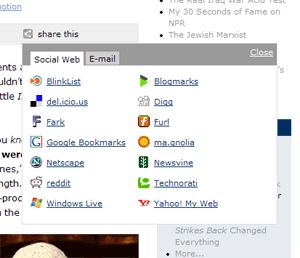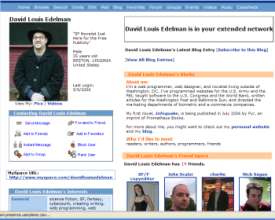[Quick reminder before we get underway: my Jewish Marxist Werewolves in Bolivia Infoquake giveaway contest is still open! Deadline is this Friday, and lots of opportunity for you — yes, you — to win a signed copy of the book.]
I’ve nearly completed all the modifications I wanted to make on this blog for 2007. Finally this weekend I cleared one of the last remaining hurdles: a good hook to social bookmarking and Web 2.0 sites.
I found that hook with Alex King’s Share This plug-in for WordPress.

Look at the gray bar underneath the headline of any article on this site. Along with “permanent link,” “comments,” and “trackback,” there’s now a “share this” link. Click it and give it a whirl. (If you’re viewing this article on LiveJournal, MySpace, or SFNovelists, you can look at the screen shot to the right instead. Or view this article on my WordPress blog.)
The Share This plug-in is a godsend, because it eliminates the bane of so many blogs and websites these days: the growing clutter of Web 2.0 link buttons. We’ve all seen them. They’ve spread throughout the footers and sidebars of the World Wide Web like kudzu. Alex’s plug-in takes the whole kit-n-caboodle and tucks it nicely in a dynamic pop-up. Look, ma, no mess!
The list is fairly easy to configure if you’re comfortable editing a well-commented PHP document. You can use the list of other social web-type services found on 3spots’ list of blog footer buttons. Obviously I don’t have accounts with all these services, so all y’all blog readers will have to let me know if there’s a button that’s misbehaving. And let me know if there are any services I’m missing.
So far, the plug-in seems to be working extraordinarily well, and I can only hope it will allow my blog to continue to grow and dominate the blogosphere. Perhaps next year, I’ll look back at all the rival bloggers I’ve mercilessly slain on the field of Technorati and have Alex King to thank for it. (Hopefully Mr. King will even forgive me for grayscaling his nice standardized share icon.)
Of course, there’s always room for improvement, so I’m going to throw in my two cents about things I’d add or change in the plug-in.
 Gmail should be a slam-dunk for Google. After all, I can build a simple POP3 application on a ColdFusion web server in a couple of hours, and that includes time for me to consult the Macromedia documentation to fix my mangled CFML syntax. I’m not saying that that’s all there is to it, of course. (If you want to see a ColdFusion-based application gone horribly awry, look at all the
Gmail should be a slam-dunk for Google. After all, I can build a simple POP3 application on a ColdFusion web server in a couple of hours, and that includes time for me to consult the Macromedia documentation to fix my mangled CFML syntax. I’m not saying that that’s all there is to it, of course. (If you want to see a ColdFusion-based application gone horribly awry, look at all the  Here’s the problem: MySpace is an abomination. Nothing works. The things that do work are poorly designed and shoddily implemented. Here’s just a small sampling of problems I’ve been having:
Here’s the problem: MySpace is an abomination. Nothing works. The things that do work are poorly designed and shoddily implemented. Here’s just a small sampling of problems I’ve been having: